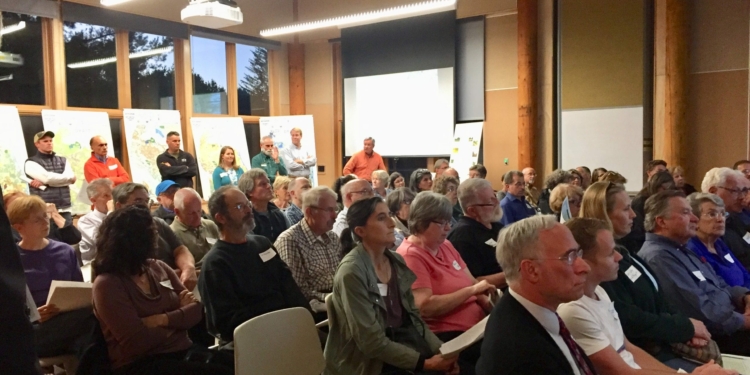DELMAR — Around 100 town residents attended the first of two public meetings, that are part of Phase II of the town’s open space planning process, on Thursday, Oct. 12, asking questions and providing feedback about items including the town’s conservation easement exemption program, conservation criteria maps, and the potential for a dedicated open spaces fund.
Following a public presentation to the Town Board scheduled for Nov. 8, the Planning Department expects to hold another public meeting before finalizing an open space plan that will be used to guide the town in its open space conservation efforts.
During the public meeting, residents were able to visit different stations that had been set up to visually explain certain aspects of the planning process, such as the development of open space value maps and what conservation tools are currently available to them.
“We’re trying to make informed decisions about what to protect and how,” said Karen Shaw, the Planning Department’s part-time open spaces czar. Explaining that the vast majority of remaining open space in Bethlehem belongs to private landowners, Shaw said the development of the value maps was not intended as an action plan, but as a preparedness plan.

“We’re not targeting landowners,” she said. “We’re not even encouraging them. But, the market moves so fast that we think it’s a good idea to be prepared if a landowner maybe can’t afford to keep up with taxes but would prefer not to sell to a developer. Then they could come to us and we could help them find a way to preserve that open space that works for them.”
Right now, there are essentially only two ways that the town can facilitate the preservation of open space: 1) the town can approve a development as a conservation subdivision or a planned development district, in which considerable development may still occur but the developer is allowed to increase density in exchange for conserving a percentage of the land parcel as open space; or 2) pending approval by the town’s Conservation Easement Review Board (CERB) and the Town Board, a resident can apply for a Conservation Easement Exemption to place five or more acres of contiguous land under preservation in exchange for property tax relief (up to 90 percent for perpetual preservation).
In the future, planners discussed the possibility of either purchasing properties deemed important to preserve, or property development rights. To do so, however, the town would need to have some sort of funding mechanism, such as levying a small (not greater than 2 percent) transfer tax, seeking grant funds, soliciting donations, or some combination of those. That, said Shaw, is a conversation that is still ongoing.

Until then, the emerging plan — including the value maps and a conservation analysis tool that objectively values properties by analyzing them for 25 valued open space characteristics, such as biodiversity, proximity to public spaces or historical significance — will help CERB make decisions regarding which parcels to approve for the tax exemption program. But, explained Shaw, if the town establishes a dedicated fund, a plan will also be necessary to apply for grant funding. In general, while it will provide guidance to the town moving forward — it is not meant to establish iron-clad rules.
“There’s always a human element,” she said. “While a property may only have three or four of the 25 criteria identified in the assessment tool, it may be directly adjacent to a town park and maybe the owner is willing to consider public access. That could weight the decision-making process in favor of preservation.”
Shaw enjoys talking to interested landowners and welcomes calls from residents interested in learning about their options. Each piece of land is unique, she said, and each landowner’s situation is different. In some cases, connecting them with conservation nonprofits like the Mohawk Hudson Land Conservancy, which offers its own conservation easement program, is what works. In others, a landowner might conserve a portion of their land and develop another.
“This process is intended to harm no one and to help everyone,” Shaw said, acknowledging that some landowners still seem distrustful. “We’re trying desperately to be as transparent as we possibly can and want to make sure that everyone knows that the landowners’ rights are paramount.”
Representatives in state government are trying to pass legislation that would establish a dedicated open space fund in Bethlehem, and allow the town to levy a transfer tax — no greater than 2 percent — to pay into that fund. While critics have decried the move as a sneaky way to raise taxes on residents, proponents have pointed out that the few municipalities to have already passed such legislation have levied no either no tax, or a fraction of a percent, and that any new tax would require a town-wide vote before taking effect.
“There are a lot of checks and balances here,” said Shaw, challenging assertions made by at least two candidates for town office that the fund would be misused by town officials.
“Nothing is set in stone,” she said, noting that the idea to develop an open space plan in Bethlehem was first proposed in 2005, during the development of the town’s comprehensive plan, and has since been revisited and recommended by several other planning committees. “But we really want to get something on paper.”



